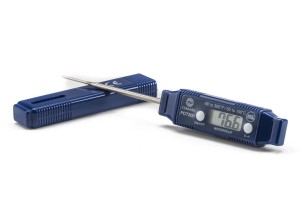That’s what I told Lydia Zuraw of Food Safety News when she and I spoke last week about my favorite kitchen tool, the tip-sensitive digital thermometer (below, exactly as shown). We chatted about cold spots, microwaving and checking internal temperatures in multiple spots.
I also told her that my very first thermometer came as a gift from the infamous Pete Snyder. It was during the testing of food safety infosheets and Pete had been providing feedback on specific kinds of thermometers and why. And Pete’s suggestions came with publications and references. One day my very own Comark PDT 300 showed up unannounced in the mail.
“It’s a tool just like a frying pan,” says Benjamin Chapman, associate professor of food safety at North Carolina State University. “The more you cook, the more investment you put into your tools.”
As for dial thermometers, or bi-metallic stems, they’re “not great tools,” Chapman says. “They’re fine in a jam, but they do have to be calibrated.”
They also aren’t as precise – as the dial provides an average temperature between the tip and a dimple, sometimes an inch away. That makes me nervous as the surface of a thick piece of meat may be 20 or 30 degrees warmer than an inch inside.
